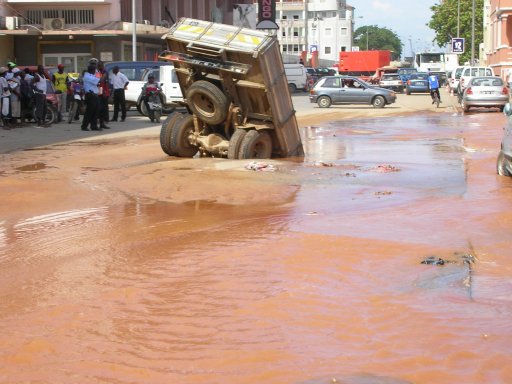
Enthusiast I
I thought this would be a fun topic, especially since I have a great photo to share. I used to live in Angola (loved it actually). We had two driving rules that we never violated:
The second rule may not be entirely obvious to westerners, especially in the city, but water hides many hazards, some larger than you might expect. The most common hazard in the city was missing manhole covers. There were always more manholes than manhole covers and dropping a wheel in one of those at speed was a great way to bust an axle. The other great example of why we always followed this rule even in the city is best explained with this photo:

That is not half a truck, that is a whole truck. Sometimes those water holes are deeper than you might think. Never drive through water (unless you first walk it).
The third rule was probably actually rule #1 in Angola. Angola didn't have predators, but it did have poisonous snakes and a 25 year civil war. Land mines were used heavily to around cities, industrial bases, etc... You could safely walk or drive where hundreds have gone before you, but you never pulled off the side of the road or stepped off the beaten path for fear of finding a mine. You also didn't walk in the grass even in what should be a safe area for fear of finding a snake. I used to go to braais with the road workers. They were always hitting mines when the blade of the grader wandered a bit into the grass at the side of the road. So rule #3 is about staying on established paths and trails only when in former conflict zones.
So please join in with your rules for safe overlanding and give stories to bring the lesson home if you have them.
-Chris.
- Never drive outside the city after dark.
- Never drive through standing water without first checking it.
- Never walk or drive in the grass (in former conflict zones).
The second rule may not be entirely obvious to westerners, especially in the city, but water hides many hazards, some larger than you might expect. The most common hazard in the city was missing manhole covers. There were always more manholes than manhole covers and dropping a wheel in one of those at speed was a great way to bust an axle. The other great example of why we always followed this rule even in the city is best explained with this photo:

That is not half a truck, that is a whole truck. Sometimes those water holes are deeper than you might think. Never drive through water (unless you first walk it).
The third rule was probably actually rule #1 in Angola. Angola didn't have predators, but it did have poisonous snakes and a 25 year civil war. Land mines were used heavily to around cities, industrial bases, etc... You could safely walk or drive where hundreds have gone before you, but you never pulled off the side of the road or stepped off the beaten path for fear of finding a mine. You also didn't walk in the grass even in what should be a safe area for fear of finding a snake. I used to go to braais with the road workers. They were always hitting mines when the blade of the grader wandered a bit into the grass at the side of the road. So rule #3 is about staying on established paths and trails only when in former conflict zones.
So please join in with your rules for safe overlanding and give stories to bring the lesson home if you have them.
-Chris.
Last edited:





